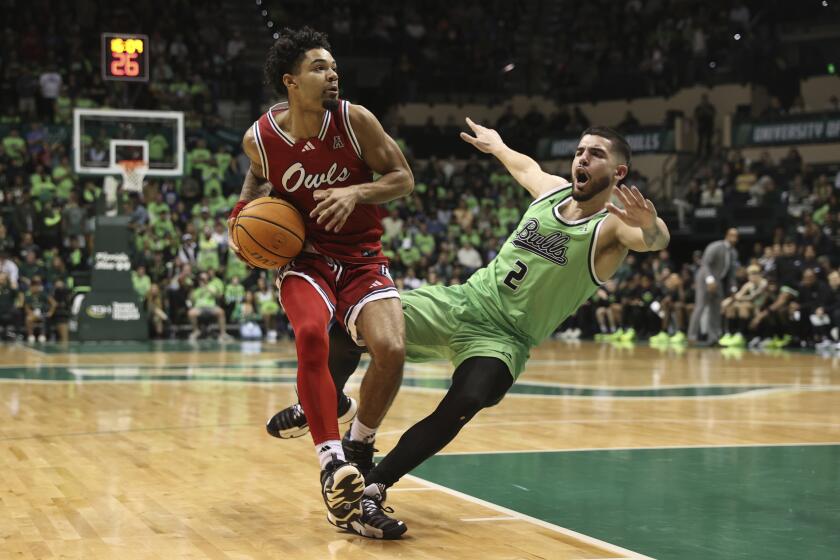Column: US soccer and the continued failure of its pay-to-play model
In 1998, U.S. Soccer brass proudly rolled out Project 2010, a $50 million plan to win the men’s World Cup in 12 years. There were flow charts and speeches, pledges to open residential academies and hire more talent scouts, incremental goals and big dreams.
Someone raised his hand and asked, in the spirit of Title IX, if it applied to the U.S. women’s program, which had already won the inaugural World Cup and would win another a year later.
The plan for the women, the national team general manager stuttered, was to “win forever.”
Fast-forward two decades, to a Twitter account belonging to an American man who married the daughter of Dutch soccer legend Johan Cruyff and now runs the respected TOVO youth academy in Barcelona. The U.S. women were about to face Spain in the final group game of the Under-20 Women’s World Cup in France, with a spot in the quarterfinals at stake. The U.S. needed a win to advance, Spain a tie.
Todd Beane warned about a rapidly improving Spanish program despite finishing 20th in its only World Cup appearance and suggested the American women might want to innovate “NOW” despite the perception that they rule the sport based on the senior team’s No. 1 world ranking.
“Complacency,” Beane tweeted, “cripples progress.”
Prescient words. Spain took a 2-0 lead in the first half, then hung on for a 2-2 tie after the Americans equalized in the 87th minute on a deflected shot. It was enough to eliminate the mighty Yanks in the first round for the first time since FIFA began hosting U-20 Women’s World Cups in 2002.
Lest you think this is an aberration, let’s look at the most recent results from the top U.S. men’s and women’s national teams.
- Senior men: Failed to qualify for the World Cup for the first time since 1986.
- Under-23 men: Failed to qualify for the last two Olympics.
- Senior women: Eliminated in the quarterfinals of the 2016 Olympics (which is not under-23 for women), their worst-ever finish after winning four gold medals and one silver.
- Under-20 women: Since winning in 2012, it’s been quarterfinals, fourth place and out in the first round.
The men failing to qualify for the 2018 World Cup got all the publicity, of course. But what happened Monday on a cloudy day in Lehon, France, might have been a bigger embarrassment, a louder alarm bell, a greater cry for change, given the almost unfair advantages the U.S. women enjoy.
The last global count by FIFA, soccer’s world governing body, found that the U.S. has as many female players as the rest of the planet combined. There currently are about 1.5 million registered female youth players, depending on which database you use; Spain, according to soccer’s European federation, has 20,590.
Perspective: San Diego County alone has two or three times that.
For this particular age group, thanks to Title IX, Team USA can draw on 333 Division I women’s soccer programs with 14 full scholarships each.
Plus another 300 at Div. II.
Plus another 300 at Div. III.
Plus 208 at NAIA.
Plus hundreds more at junior colleges.
They should win forever.
That they don’t is an indictment of a pay-to-play youth system that everyone seems to agree is broken but no one can agree how to fix, that doesn’t develop players organically but in a capitalistic test tube that spits out blonde-haired, pony-tailed robots.
“A rich, white kid sport,” as former U.S. goalkeeper Hope Solo puts it.
And understand this: Pay-to-play isn’t going anywhere. There’s too much money involved and too many people making it for that to change. Do the math: With about 3 million boys and girls registered youth players paying, say, an average of $1,500 each per year, that’s a $4.5 billion industry.
Here’s how it goes: You sign up your kid for rec soccer at age 6, just to get them outside running around, innocently wanting them to absorb the values of team sports.
At 8, acting on the universal fear of parents not wanting their kid to fall behind, you join a club. It costs $1,200 to $1,500 per year, plus another couple hundred for tournaments, plus the hidden cost of gas and hotels for that out-of-town tournament so you can tell your friends your kid is on a “travel team,” plus $12 to park at some venues. You also might hire private coaches at $50 or $100 per hour.
At 10, you are recruited to a more prestigious, more expensive club loaded with big, strong kids that has better chance of winning State Cups, since most parents, not versed in the nuances of the sport, equate trophies with development.
At 13, if your kid is good enough, you make a team in the U.S. Soccer Development Academy. It costs $2,500 to $3,000 per year, and the travel can double or triple that amount. You practice four days a week, take plane trips for some away games, aren’t guaranteed playing time on rosters that can be as large as 24, are discouraged from playing other sports and are forbidden from playing high school soccer.
Pay even more to play.
And here’s what we get:
A bunch of players who have favorable birthdays right after the age cut-off and hit puberty early.
Who play less for a genuine love of the game than the pursuit of an elusive college scholarship.
Who don’t reap the vital mental and physical benefits, physicians and psychologists keep telling us, from playing multiple sports.
Who don’t understand the honor and responsibility of representing an entire high school community instead of the just parents in lawn chairs writing the checks.
Who often never acquire the sophisticated tactical and cognitive skills that soccer ultimately demands, either because their coach was obsessed with winning or because they merely relied on their preadolescent athletic superiority.
And who, on a cloudy day in a tiny town in northwestern France, can’t beat a country with a mere 20,590 registered youth women’s players and no Title IX college scholarships.
“Our fragile advantage in ‘athleticism’ will wilt in the face of intelligence,” Beane, a Dartmouth and Stanford alum with European perspective from his youth academy in Barcelona, wrote me on social media. “Until we abandon our arrogance and complacency based upon past success, we will not adequately prepare our young players for the future. We have a unique opportunity now on both the men’s and women’s side of U.S. Soccer to rethink and redesign talent development.
“Innovation is a cornerstone of U.S. culture in so many industries, and yet in soccer we train our players based upon a paradigm introduced 30 years ago … Nations that just now are finally supporting women’s soccer will hold no sympathy for us as they outplay us with a much more profound understanding of the game than our young players currently hold.”
U.S. Soccer, meanwhile, slides more chips on the table. It’s doubling down.
The Development Academy started for boys in 2007 and, last year, was added for girls. Previously, the highest level for girls was the Elite Clubs National League (ECNL), which was the same idea but not as intense and which produced 20 of the 21 players on the under-20 roster in France.
More structure, more pressure, more money, more robots.
It’s the opposite of how basketball players are bred in this country – in rec centers and rutted outdoor courts with frayed nets, without coaches or parents, without uniforms or referees, in pick-up games where kids hone one-on-one skills without the fear of adult disapproval, with freedom and creativity. Sound familiar? Ask Brazilian soccer stars where they got their start.
But the coaches and club officers (one club director in town, according to public records, makes $155,000 per year) need to be paid. Parking fees need to be collected. Cones need to be laid out in perfect lines. Labor Day tournaments need to be won. Parents, the consumer here, need to be satisfied.
Responding to a series of Twitter posts about the under-20’s elimination in France, one dad noted: “This is a sobering tweet as I load my 8-year-old girl into the car after the first of three practices for the week.”
Another lamented: “And yes, they cash my checks because I’m a sucker, too.”
Some solutions for the broken youth soccer system »
Aztecs


Video: Aztecs make history with upset over No. 6 Nevada

Aztecs prepare for Fresno State

Aztecs beat New Mexico, 97-77

Dutcher, Aztecs prepare for Air Force

Aztecs beat Wyoming, 84-54

Aztecs prepare for conference game against Boise

Aztecs beat Texas Southern, 103-64

Rocky Long: "This team has overachieved"

SDSU West bests SoccerCity as voters embrace a new vision for Mission Valley stadium site

Aztecs win season opener, 76-60
Go deeper inside the Padres
Get our free Padres Daily newsletter, free to your inbox every day of the season.
You may occasionally receive promotional content from the San Diego Union-Tribune.










